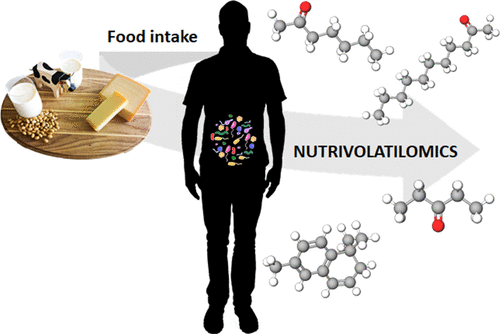当前位置:
X-MOL 学术
›
J. Proteome Res.
›
论文详情
Our official English website, www.x-mol.net, welcomes your
feedback! (Note: you will need to create a separate account there.)
Nutrivolatilomics of Urinary and Plasma Samples to Identify Candidate Biomarkers after Cheese, Milk, and Soy-Based Drink Intake in Healthy Humans.
Journal of Proteome Research ( IF 3.8 ) Pub Date : 2020-09-03 , DOI: 10.1021/acs.jproteome.0c00324 Pascal Fuchsmann 1 , Mireille Tena Stern 1 , Linda H Münger 1 , Grégory Pimentel 1 , Kathryn J Burton 1 , Nathalie Vionnet 2 , Guy Vergères 1
Journal of Proteome Research ( IF 3.8 ) Pub Date : 2020-09-03 , DOI: 10.1021/acs.jproteome.0c00324 Pascal Fuchsmann 1 , Mireille Tena Stern 1 , Linda H Münger 1 , Grégory Pimentel 1 , Kathryn J Burton 1 , Nathalie Vionnet 2 , Guy Vergères 1
Affiliation

|
The characterization of volatile compounds in biological fluids offers a distinct approach to study the metabolic imprint of foods on the human metabolome, particularly to identify novel biomarkers of food intake (BFIs) that are not captured by classic metabolomics. Using a combination of dynamic headspace vacuum transfer In Trap extraction and gas chromatography coupled with mass spectrometry, we measured volatile compounds (the “volatilome”) in plasma and urine samples from a randomized controlled crossover intervention study in which 11 healthy subjects ingested milk, cheese, or a soy-based drink. More than 2000 volatile compounds were detected in plasma, while 1260 compounds were detected in urine samples. A postprandial response in plasma was confirmed for 697 features. Univariate and multivariate analyses identified four molecules in plasma and 31 molecules in urine samples differentiating the ingestion of the foods, of which three metabolites in plasma and nine in urine were specific to the dairy products. Among these molecules, heptan-2-one, 3,5-dimethyloctan-2-one, and undecan-2-one in plasma and 3-ethylphenol, heptan-2-one, 1-methoxy-2-propyl acetate, and 9-decenoic acid were highly discriminative for dairy or cheese intake. In urine, 22 volatile compounds were highly discriminative for soy-based drink intake. The majority of these molecules have not been reported in humans. Our findings highlight the potential of plasma and urinary volatilomics for detection of novel dietary biomarkers.
中文翻译:

尿液和血浆样品的营养成分研究,以鉴定健康人奶酪,牛奶和大豆饮料摄入后的候选生物标志物。
生物流体中挥发性化合物的表征提供了一种独特的方法来研究食物在人体代谢组上的代谢烙印,尤其是鉴定经典代谢组学未捕获的食物摄入的新型生物标志物。结合动态顶空真空转移在捕集阱萃取,气相色谱和质谱联用中,我们测量了来自随机对照交叉干预研究的血浆和尿液样品中的挥发性化合物(“挥发性有机化合物”),其中11名健康受试者摄入了牛奶,奶酪或大豆饮料。在血浆中检测到2000多种挥发性化合物,而在尿液样品中检测到1260种化合物。血浆中餐后反应已确认为697个特征。单因素和多因素分析确定了血浆中的四个分子和尿液样品中的31个分子,从而区分了食物的摄入,其中血浆中的三种代谢物和尿液中的9种代谢产物是乳制品特有的。在这些分子中,血浆中的庚烷-2-酮,3,5-二甲基辛烷-2-酮和十一烷-2-酮与3-乙基苯酚,庚烷-2-酮,乙酸1-甲氧基-2-丙酯和9 -癸烯酸对于乳制品或奶酪的摄入具有高度的歧视性。在尿液中,有22种挥发性化合物对基于大豆的饮料摄入量具有很高的判别力。这些分子中的大多数尚未在人类中报道。我们的发现突出了血浆和尿液挥发物检测新型饮食生物标志物的潜力。其中血浆中的三种代谢产物和尿液中的九种代谢产物是乳制品特有的。在这些分子中,血浆中的庚烷-2-酮,3,5-二甲基辛烷-2-酮和十一烷-2-酮与3-乙基苯酚,庚烷-2-酮,乙酸1-甲氧基-2-丙酯和9 -癸烯酸对于乳制品或奶酪的摄入具有高度的歧视性。在尿液中,22种挥发性化合物对于基于大豆的饮料摄入具有高度的判别力。这些分子中的大多数尚未在人类中报道。我们的发现突出了血浆和尿液挥发物检测新型饮食生物标志物的潜力。其中血浆中的三种代谢产物和尿液中的九种代谢产物是乳制品特有的。在这些分子中,血浆中的庚烷-2-酮,3,5-二甲基辛烷-2-酮和十一烷-2-酮与3-乙基苯酚,庚烷-2-酮,乙酸1-甲氧基-2-丙酯和9 -癸烯酸对于乳制品或奶酪的摄入具有高度的歧视性。在尿液中,22种挥发性化合物对于基于大豆的饮料摄入具有高度的判别力。这些分子中的大多数尚未在人类中报道。我们的发现突出了血浆和尿液挥发物检测新型饮食生物标志物的潜力。在尿液中,22种挥发性化合物对于基于大豆的饮料摄入具有高度的判别力。这些分子中的大多数尚未在人类中报道。我们的发现突出了血浆和尿液挥发物检测新型饮食生物标志物的潜力。在尿液中,22种挥发性化合物对于基于大豆的饮料摄入具有高度的判别力。这些分子中的大多数尚未在人类中报道。我们的发现突出了血浆和尿液挥发物检测新型饮食生物标志物的潜力。
更新日期:2020-10-02
中文翻译:

尿液和血浆样品的营养成分研究,以鉴定健康人奶酪,牛奶和大豆饮料摄入后的候选生物标志物。
生物流体中挥发性化合物的表征提供了一种独特的方法来研究食物在人体代谢组上的代谢烙印,尤其是鉴定经典代谢组学未捕获的食物摄入的新型生物标志物。结合动态顶空真空转移在捕集阱萃取,气相色谱和质谱联用中,我们测量了来自随机对照交叉干预研究的血浆和尿液样品中的挥发性化合物(“挥发性有机化合物”),其中11名健康受试者摄入了牛奶,奶酪或大豆饮料。在血浆中检测到2000多种挥发性化合物,而在尿液样品中检测到1260种化合物。血浆中餐后反应已确认为697个特征。单因素和多因素分析确定了血浆中的四个分子和尿液样品中的31个分子,从而区分了食物的摄入,其中血浆中的三种代谢物和尿液中的9种代谢产物是乳制品特有的。在这些分子中,血浆中的庚烷-2-酮,3,5-二甲基辛烷-2-酮和十一烷-2-酮与3-乙基苯酚,庚烷-2-酮,乙酸1-甲氧基-2-丙酯和9 -癸烯酸对于乳制品或奶酪的摄入具有高度的歧视性。在尿液中,有22种挥发性化合物对基于大豆的饮料摄入量具有很高的判别力。这些分子中的大多数尚未在人类中报道。我们的发现突出了血浆和尿液挥发物检测新型饮食生物标志物的潜力。其中血浆中的三种代谢产物和尿液中的九种代谢产物是乳制品特有的。在这些分子中,血浆中的庚烷-2-酮,3,5-二甲基辛烷-2-酮和十一烷-2-酮与3-乙基苯酚,庚烷-2-酮,乙酸1-甲氧基-2-丙酯和9 -癸烯酸对于乳制品或奶酪的摄入具有高度的歧视性。在尿液中,22种挥发性化合物对于基于大豆的饮料摄入具有高度的判别力。这些分子中的大多数尚未在人类中报道。我们的发现突出了血浆和尿液挥发物检测新型饮食生物标志物的潜力。其中血浆中的三种代谢产物和尿液中的九种代谢产物是乳制品特有的。在这些分子中,血浆中的庚烷-2-酮,3,5-二甲基辛烷-2-酮和十一烷-2-酮与3-乙基苯酚,庚烷-2-酮,乙酸1-甲氧基-2-丙酯和9 -癸烯酸对于乳制品或奶酪的摄入具有高度的歧视性。在尿液中,22种挥发性化合物对于基于大豆的饮料摄入具有高度的判别力。这些分子中的大多数尚未在人类中报道。我们的发现突出了血浆和尿液挥发物检测新型饮食生物标志物的潜力。在尿液中,22种挥发性化合物对于基于大豆的饮料摄入具有高度的判别力。这些分子中的大多数尚未在人类中报道。我们的发现突出了血浆和尿液挥发物检测新型饮食生物标志物的潜力。在尿液中,22种挥发性化合物对于基于大豆的饮料摄入具有高度的判别力。这些分子中的大多数尚未在人类中报道。我们的发现突出了血浆和尿液挥发物检测新型饮食生物标志物的潜力。











































 京公网安备 11010802027423号
京公网安备 11010802027423号